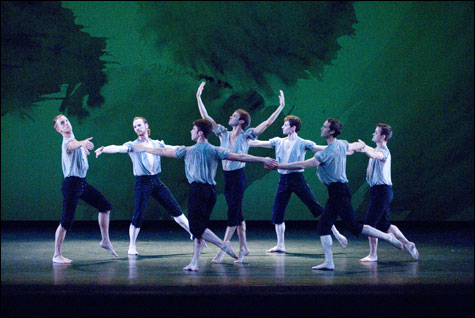
MOZART DANCES: In the Andante of Double, the men circle slowly, swooping together with joined hands and coy chains and wavy formations that look as if they could have been invented by Isadora Duncan. |
The eponymous directors of Alonzo King Lines Ballet and the Mark Morris Dance Group both came from backgrounds in modern dance with sprinklings of other styles, and they both subsequently invented movement vocabularies to serve their choreographic ideas. Beyond those fundamental similarities, the two companies couldn't be more different. Lines luxuriates in the body's physicality, a cavalcade of technical thrills and sensuous shapings. The Morris Group puts itself at the service of a compositional structure that's built on a blueprint of important classical music.
Appearing January 22-24 at the ICA, in a World Music/CRASHarts presentation, the San Francisco–based Lines Ballet performed a new piece by King, Dust and Light, and a revival of his 1995 Signs and Wonders, which he made for Dance Theater of Harlem. Both pieces begin with a single dancer on stage modeling a movement state that transfers to the other dancers in turn. In Signs and Wonders, a beautiful black man wearing next to nothing flexes and spirals, showing off and at the same time enjoying the power of his gleaming muscles and limbs. A woman on pointe picks her way across a carpet of light at the beginning of Dust and Light, secure in her ability to balance even when she bends over double or folds up in a squat.
Signs and Wonders is set to assorted chants, drummings, and rhythm songs by unattributed "traditional African" groups; Dust and Light interpolates bits of sacred choral pieces by Francis Poulenc into slow sections from several Baroque concerti by Archangelo Corelli. One dance seems simply a celebration of extravagant movement, the other a litany of suffering and broken souls. Neither piece offered much in the way of character or dramatic form that would mold the movement into some transcendent meaning, though company rhetoric indicates there are lofty intentions behind it all.
The 10 dancers assemble at the beginning of Signs and Wonders, each doing his or her own movement and phrasing. They slather themselves with circling, twisting gestures of arms and legs, then telescope out into piercing verticality. Gradually they pick up movement motifs from one another, echoing at a distance, clustering in small groups. Classically trained, they move through stretchy, tricky stanzas of that anti-classical duet you can see in almost any contemporary-dance repertory. The men do episodes of flashy jumping and turning; the women breeze around on pointe. But their actions, however imposing, don't accumulate into large stage designs.
Before the dance was half over, I felt so bombarded by King's movement invention that everything began to look alike, even though nothing was the same. In Dust and Light, the curves and easy flow had tightened up and the movement looked more angular, awkward, even at moments deranged. The duet occurred another four or five times, its tensions and graspings becoming more elaborate, the attractions between partners more like dependency than eroticism.